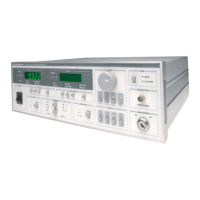REMOTE OPERATION
ANSI/IEEE-488.2 Definitions
44 LDC-3900 Series
CHAPTER 3
<PROGRAM DATA> (Parameters)
Parameters (and other <PROGRAM DATA>) may be entered after a command in
a <PROGRAM MESSAGE UNIT>. The <COMMAND PROGRAM HEADER>
(command) and first <PROGRAM DATA UNIT> (parameter) must be separated by
a <PROGRAM HEADER SEPARATOR> (white space), see White Space on page
39.
<ARBITRARY BLOCK PROGRAM DATA>
This element allows any 8-bit bytes (including extended ASCII) to be transmitted
in a message. The syntax for an <ARBITRARY BLOCK PROGRAM DATA>
element is:
Figure 3.7 <ARBITRARY BLOCK PROGRAM DATA> Syntax Diagram
-where a non-zero digit is defined as a single ASCII encoded byte in the range 31
-39 (49 - 57 decimal). 8-bit data byte is defined as an 8-bit byte in the range 00 -
FF (0 -255 decimal). NL is a new line (LF) and ^END is an end or identify (EOI).
This element is used only with a *PUD command to the LDC-3900 Modular Laser
Diode Controller.
<PROGRAM DATA SEPARATORS>
When there is a list of <PROGRAM DATA UNITS> (parameters) following a
<PROGRAM HEADER SEPARATOR> (white space), the <PROGRAM DATA
UNITS> must be separated with a <PROGRAM UNIT SEPARATOR>. The syntax
<8-bit
data
byte>
<digit>
0
<non-
zero
digit>
#
NL ^END
data
byte>
<8-bit

